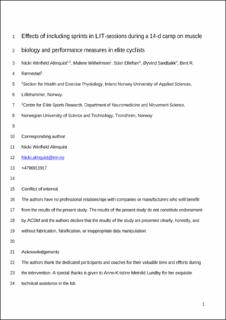| dc.description.abstract | Purpose
This study investigated the effects of including sprints within low-intensity training (LIT) sessions during a 14-d training camp focusing on LIT, followed by 10-d recovery (Rec), on performance and performance-related measures in elite cyclists.
Methods
During the camp, a sprint training group (SPR; n = 9) included 12 × 30-s maximal sprints during five LIT sessions, whereas a control group (CON; n = 9) performed distance-matched LIT only. Training load was equally increased in both groups by 48% ± 27% during the training camp and subsequently decreased by −56% ± 23% during the recovery period compared with habitual training. Performance tests were conducted before the training camp (Pre) and after Rec. Muscle biopsies, hematological measures, and stress/recovery questionnaires were collected Pre and after the camp (Post).
Results
Thirty-second sprint (SPR vs CON: 4% ± 4%, P < 0.01) and 5-min mean power (SPR vs CON: 4% ± 8%, P = 0.04) changed differently between groups. In muscle, Na+-K+ β1 protein content changed differently between groups, decreasing in CON compared with SPR (−8% ± 14%, P = 0.04), whereas other proteins showed similar changes. SPR and CON displayed similar increases in red blood cell volume (SPR: 2.6% ± 4.7%, P = 0.07; CON: 3.9% ± 4.5%, P = 0.02) and V˙O2 at 4 mmol·L−1 [BLa−] (SPR: 2.5% ± 3.3%, P = 0.03; CON: 2.2% ± 3.0%, P = 0.04). No changes were seen for V˙O2max, Wmax, hematological measures, muscle enzyme activity, and stress/recovery measures.
Conclusions
Inclusion of 30-s sprints within LIT sessions during a high-volume training camp affected competition-relevant performance measures and Na+-K+ β1 protein content differently from LIT only, without affecting sport-specific stress/recovery or any other physiological measure in elite cyclists. | en_US |
